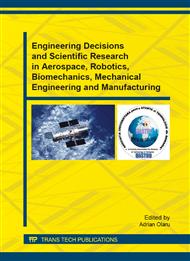[1]
Y. Yan, A. Neville, D. Dowson, S. Williams, Tribocorrosion in implants-assessing high carbon and low carbon Co–Cr–Mo alloys by in situ electrochemical measurements, Tribol Int 39 (2006) 1509–1517.
DOI: 10.1016/j.triboint.2006.01.016
Google Scholar
[2]
S. Mischler, S. Debaud, D Landolt, Wear-accelerated corrosion of passive metals in tribocorrosion systems, J Electrochem Soc 145(3) (1998) 750–758.
DOI: 10.1149/1.1838341
Google Scholar
[3]
D. Landolt, S. Mischler, M. Stemp, Electrochemical methods in tribocorrosion: a critical appraisal, Electrochim Acta 46 (2001) 3913–3929.
DOI: 10.1016/s0013-4686(01)00679-x
Google Scholar
[4]
A. Iwabuchi, J.W. Lee, M. Uchidate, Synergistic effect of fretting wear and sliding wear of Co-alloy and Ti-alloy in Hanks' solution, Wear 263 (2007) 492–500.
DOI: 10.1016/j.wear.2007.01.102
Google Scholar
[5]
J.O. Bello, R.J. K Wood, J.A. Wharton, Synergistic effects of micro-abrasion–corrosion of UNS S30403, S31603 and S32760 stainless steels, Wear 263 (2007) 149-159.
DOI: 10.1016/j.wear.2006.12.044
Google Scholar
[6]
D. Sun, J.A. Wharton, R.J. K Wood, Abrasive size and concentration effects on the tribo-corrosion of cast CoCrMo alloy in simulated body fluids", Tribol Int 42 (2009) 1595–1604.
DOI: 10.1016/j.triboint.2009.03.018
Google Scholar
[7]
J. -P. Celis, P. Ponthiaux, F. Wenger, Tribo-corrosion of materials: Interplay between chemical, electrochemical, and mechanical reactivity of surfaces, Wear 261 (2006) 939–946.
DOI: 10.1016/j.wear.2006.03.027
Google Scholar
[8]
P. Majumdar, S.B. Singh, M. Chakraborty, Wear response of heat-treated Ti–13Zr–13Nb alloy in dry condition and simulated body fluid, Wear 264 (2008) 1015–1025.
DOI: 10.1016/j.wear.2007.08.005
Google Scholar
[9]
CHEN Jun, YAN Feng-yuan, Tribocorrosion behaviors of Ti−6Al−4V and Monel K500 alloys sliding against 316 stainless steel in artificial seawater, Trans. Nonferrous Met. Soc. China 22 (2012) 1356−1365.
DOI: 10.1016/s1003-6326(11)61326-5
Google Scholar
[10]
M. Dourandish, D. Godlinski, A. Simchi, V. Firouzdor, Sintering of biocompatible P/M Co–Cr–Mo alloy (F-75) for fabrication of porosity-graded composite structures, Mater Sci Eng 472 (2008) 338–346.
DOI: 10.1016/j.msea.2007.03.043
Google Scholar
[11]
S. Spriano, E. Verne, M.G. Faga, S. Bugliosi, G. Maina, Surface treatment on an implant cobalt alloy for high biocompatibility and wear resistance, Wear 259 (2005) 919–925.
DOI: 10.1016/j.wear.2005.02.011
Google Scholar
[12]
A. Bloyce, P. -Y. Qi, H. Dong, T. Bell, Surface modification of titanium alloys for combined improvements in corrosion and wear resistance, Surf Coat Tech 107 (1998) 125–132.
DOI: 10.1016/s0257-8972(98)00580-5
Google Scholar
[13]
Suresh Kuiry, Evaluation of Wear-Corrosion Synergy Through Tribocorrosion Studie, USA: Bruker, (2012).
Google Scholar
[14]
Y. Huang, X. Jiang, S. Li, Pure mechanical wear loss measurement in corrosive wear, Bull. Mater. Sci. Vol. 23 (2000) 539–542.
DOI: 10.1007/bf02903897
Google Scholar
[15]
S. Mischler, Triboelectrochemical techniques and interpretation methods in tribocorrosion: A comparative evaluation, Tribology International 41 (2008) 573–583.
DOI: 10.1016/j.triboint.2007.11.003
Google Scholar
[16]
N. Diomidis, J. -P. Celis, P. Ponthiaux, F. Wenger, A methodology for the assessment of the tribocorrosion of passivating metallic materials, Lubr Sci (2009) 53-67.
DOI: 10.1002/ls.73
Google Scholar
[17]
L. Ceschini, E. Lanzoni, C. Martini, D. Prandstraller, G. Sambogna, Comparison of dry sliding friction and wear of Ti6Al4V alloy treated by plasma electrolytic oxidation and PVD coating, Wear 264 (2008) 86–95.
DOI: 10.1016/j.wear.2007.01.045
Google Scholar
[18]
A. Stachowiak, W. Zwierzycki, Tribocorrosion modeling of stainless steel in a sliding pair of pin-on-plate type, Tribol Int 44 (2011) 1216–1224.
DOI: 10.1016/j.triboint.2011.05.020
Google Scholar
[19]
Z. Doni, A.C. Alves, F. Toptan, J.R. Gomes, A. Ramalho, M. Buciumeanu, L. Palaghian, F.S. Silva, Dry sliding and tribocorrosion behaviour of hot pressed CoCrMo biomedical alloy as compared with the cast CoCrMo and Ti6Al4V alloys, Mater Design 52 (2013).
DOI: 10.1016/j.matdes.2013.05.032
Google Scholar
[20]
T.M. Manhabosco, S.M. Tamborim, C.B. dos Santos, I.L. Müller, Tribological, electrochemical and tribo-electrochemical characterization of bare and nitrided Ti6Al4V in simulated body fluid solution, Corros Sci 53 (2011) 1786–1793.
DOI: 10.1016/j.corsci.2011.01.057
Google Scholar
[21]
F. Zivic, M. Babic, S. Mitrovic, A. Vencl, Continuous control as alternative route for wear monitoring by measuring penetration depth during linear reciprocating sliding of Ti6Al4V alloy, J Alloy Compd 509 (2011) 5748–5754.
DOI: 10.1016/j.jallcom.2011.02.158
Google Scholar
[22]
J. Qu, P.J. Blau, T.R. Watkins, O.B. Cavin, N.S. Kulkarni, Friction and wear of titanium alloys sliding against metal, polymer, and ceramic counterfaces. Wear (2005) 1348–56.
DOI: 10.1016/j.wear.2004.09.062
Google Scholar


